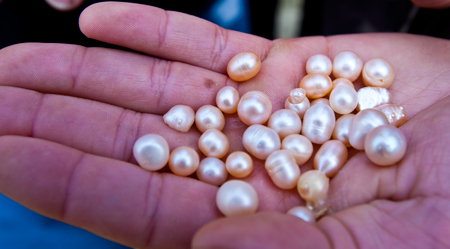
In the Hatchery department, we learned that all oysters start life as hermaphrodites, and our group was permitted to enter a dark, garage-like space with steamy temperatures ranging anywhere from 79–89 degrees-the ideal climate for oyster growth. JCB teaching us about the pearl process on T4 Tracking water levels is one task at the Jewelmer pearl farms these signs affixed to the main T4 building show just how high water levels have previously risen. According to Clara, you need a site far from pollution for healthy oysters to grow, plankton for them to eat, good current and water flow (no stagnation for bacteria to breed), and sandy-not muddy-sea conditions. Clara-a farm manager, biologist, and pearl technician with Jewelmer for 18 years-taught us prerequisites for pearl farming in a classroom-turned-office space inside a breezy bamboo hut on stilts in the water.


Some 1,200 employees (“a family,” explained JCB, who grew up playing with some staffers’ kids who now work on the farm) make up Jewelmer’s payroll. Terramar essentially means a waterfront community, and despite its great distance from the Philippines mainland, T4 is home to more than 300 employees-many men who spearfish on Saturdays for fun and food, and because it’s safest for the environment-who hail from all over the Philippines, traveling home only sporadically for family visits. Terramar Four is Jewelmer’s fourth pearl farm, and the one where we spent the most time. This post is a continuation from Friday’s Part 1 JCK visited the Jewelmer pearl farms- some of which were hit by Typhoon Haiyan-earlier this year.


 0 kommentar(er)
0 kommentar(er)
